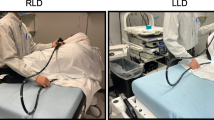Abstract
Background
Repetitive tasks in the workplace are one cause of injury. This study aimed to identify injuries specific to physicians routinely performing colonoscopy, and to identify prevention strategies.
Methods
A survey was sent to all 2,173 worldwide members of the American Society for Colon and Rectal Surgery to investigate injuries or disabilities that resulted from performing colonoscopy and the methods used to prevent and alleviate symptoms related to the procedure.
Results
The response rate was 28%. Of the respondents, 96% performed colonoscopy. At least one injury or pain believed to result from performing colonoscopy was reported by 39% of the respondents. The most frequently reported injuries were to hands and fingers (n = 257), neck (n = 65), and back (n = 52). The methods adopted to alleviate injury included changing the height of the stretcher or video monitor, changing from a standing to a sitting position, minimizing torque on the colonoscope, having an assistant perform the torque maneuver, and resting or taking time off from colonoscopy. Two respondents also created devices to make the instrument more ergonomic.
Conclusion
The number of colorectal surgeons encountering injury from colonoscopy highlights the need for preventive strategies. The study results suggest that it may be necessary to improve the design of colonoscopes to make them more ergonomic. Appropriate positioning of the endoscopist, patient, and monitors may diminish some of the injuries encountered.
Similar content being viewed by others
References
Canadian Centre for Occupational Health and Safety. Web page on work-related musculoskeletal disorders. Retrieved at http://www.ccohs.ca/oshanswers/diseases/rmirsi.html, March 1, 2005
Berguer R, Hreljac A (2004) The relationship between hand size and difficulty using surgical instruments: a survey of 726 laparoscopic surgeons. Surg Endosc 18: 508–512
Descatha A, Leclerc A, Chastang JF, Roquelaure Y (2003) Medial epicondylitis in occupational settings: prevalence, incidence and associated risk factors. J Occup Environ Med 45: 993–1001
Smith A, Wolf J, et al (1997) Musculoskeletal pain in cardiac ultrasonographers: results of a random survey. J Am Soc Echocardiogr 10: 357–362
Statistics of the U.S. Department of Labor, Bureau of Labor Statistics Web site. Retrieved http://www.bls.gov/iif/home.htm, March 1, 2005
Uhl TL, Madaleno JA (2001) Rehabilitation concepts and supportive devices for overuse injuries of the upper extremities. Clin Sports Med 20: 621–639
Verdon M (1996) Overuse syndromes of the hand and wrist: primary care. Clin Office Pract 23: 305–319
Wajon A, Ada L (2003) Prevalence of thumb pain in physical therapists practicing spinal manipulative therapy. J Hand Ther 16: 237–243
Author information
Authors and Affiliations
Corresponding author
Rights and permissions
About this article
Cite this article
Liberman, A.S., Shrier, I. & Gordon, P.H. Injuries sustained by colorectal surgeons performing colonoscopy. Surg Endosc 19, 1606–1609 (2005). https://doi.org/10.1007/s00464-005-0219-1
Received:
Accepted:
Published:
Issue Date:
DOI: https://doi.org/10.1007/s00464-005-0219-1



